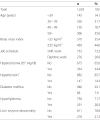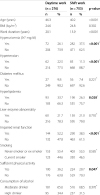2. Eurofound. 5th European Working Conditions Survey: Overview Report. 2012. Luxembourg: Publications Office of the European Union.
3. Haus E, Smolensky M. Biological clocks and shift work: circadian dysregulation and potential long-term effects. Cancer Causes Control. 2006; 17:489–500. DOI:
10.1007/s10552-005-9015-4. PMID:
16596302.
5. Nabe-Nielsen K, Garde AH, Tüchsen F, Hogh A, Diderichsen F. Cardiovascular risk factors and primary selection into shift work. Scand J Work Environ Health. 2008; 34:206–212. DOI:
10.5271/sjweh.1230. PMID:
18728910.
6. Ha M, Park J. Shiftwork and metabolic risk factors of cardiovascular disease. J Occup Health. 2005; 47:89–95. DOI:
10.1539/joh.47.89. PMID:
15824472.
7. Dochi M, Sakata K, Oishi M, Tanaka K, Kobayashi E, Suwazono Y. Relationship between shift work and hypercholesterolemia in Japan. Scand J Work Environ Health. 2008; 34:33–39. DOI:
10.5271/sjweh.1189. PMID:
18427696.
8. Lee KJ, Kim JJ. Relationship of shift work to cardiovascular and gastrointestinal symptoms in Korean female workers. Korean J Occup Environ Med. 2008; 20:362–371.
9. Brown DL, Feskanich D, Sanchez BN, Rexrode KM, Schernhammer ES, Lisabeth LD. Rotating night shift work and the risk of ischemic stroke. Am J Epidemiol. 2009; 169:1370–1377. DOI:
10.1093/aje/kwp056. PMID:
19357324.
10. Viswanathan AN, Hankinson SE, Schernhammer ES. Night shift work and the risk of endometrial cancer. Cancer Res. 2007; 67:10618–10622. DOI:
10.1158/0008-5472.CAN-07-2485. PMID:
17975006.
11. Driesen K, Jansen NW, van Amelsvoort LG, Kant I. The mutual relationship between shift work and depressive complaints-a prospective cohort study. Scand J Work Environ Health. 2011; 37:402–410. DOI:
10.5271/sjweh.3158. PMID:
21526329.
12. Wang JH, Lee G, Song JT, Kwon J, Choi H, Jung-Choi K, Lim S. The Association between Shift Work and Bone Mineral Density: analysis of 2008-2009 Korean National Health and Nutrition Examination Survey. Korean J Occup Environ Med. 2012; 24:274–286.
13. Costa G, Haus E, Stevens R. Shift work and cancer - considerations on rationale, mechanisms, and epidemiology. Scand J Work Environ Health. 2010; 36:163–179. DOI:
10.5271/sjweh.2899. PMID:
20126969.
14. Pesch B, Harth V, Rabstein S, Baisch C, Schiffermann M, Pallapies D, Bonberg N, Heinze E, Spickenheuer A, Justenhoven C, Brauch H, Hamann U, Ko Y, Straif K, Brüning T. Night work and breast cancer - results from the German GENICA study. Scand J Work Environ Health. 2010; 36:134–141. DOI:
10.5271/sjweh.2890. PMID:
20039012.
15. Flynn-Evans EE, Mucci L, Stevens RG, Lockley SW. Shiftwork and prostate-specific antigen in the National Health and Nutrition Examination Survey. J Natl Cancer Inst. 2013; 105:1292–1297. DOI:
10.1093/jnci/djt169. PMID:
23943864.
16. Verdecchia P, Schillaci G, Reboldi G, Santeusanio F, Porcellati C, Brunetti P. Relation between serum uric acid and risk of cardiovascular disease in essential hypertension. The PIUMA study. Hypertension. 2000; 36:1072–1078. DOI:
10.1161/01.HYP.36.6.1072. PMID:
11116127.
17. Baker JF, Krishnan E, Chen L, Schumacher HR. Serum uric acid and cardiovascular disease: recent developments, and where do they leave us? Am J Med. 2005; 118:816–826. DOI:
10.1016/j.amjmed.2005.03.043. PMID:
16084170.
18. Conen D, Wietlisbach V, Bovet P, Shamlaye C, Riesen W, Paccaud F, Burnier M. Prevalence of hyperuricemia and relation of serum uric acid with cardiovascular risk factors in a developing country. BMC Public Health. 2004; 4:9. DOI:
10.1186/1471-2458-4-9. PMID:
15043756.
19. Yamamoto T. [Definition and classification of hyperuricemia]. Nihon Rinsho Japanese J Clin Med. 2008; 66:636–640.
20. Lai LH, Chou SY, Wu FY, Chen JJ, Kuo HW. Renal dysfunction and hyperuricemia with low blood lead levels and ethnicity in community-based study. Sci Total Environ. 2008; 401:39–43. DOI:
10.1016/j.scitotenv.2008.04.004. PMID:
18514766.
21. Yamamoto T, Moriwaki Y, Takahashi S. Effect of ethanol on metabolism of purine bases (hypoxanthine, xanthine, and uric acid). Clin Chim Acta. 2005; 356:35–57. DOI:
10.1016/j.cccn.2005.01.024. PMID:
15936302.
22. Brule D, Sarwar G, Savoie L. Changes in serum and urinary uric acid levels in normal human subjects fed purine-rich foods containing different amounts of adenine and hypoxanthine. J Am Coll Nutr. 1992; 11:353–358. DOI:
10.1080/07315724.1992.10718238. PMID:
1619189.
23. Baldwin W, McRae S, Marek G, Wymer D, Pannu V, Baylis C, Johnson RJ, Sautin YY. Hyperuricemia as a mediator of the proinflammatory endocrine imbalance in the adipose tissue in a murine model of the metabolic syndrome. Diabetes. 2011; 60:1258–1269. DOI:
10.2337/db10-0916. PMID:
21346177.
25. Barr WG. Walker HK, Hall WD, Hurst JW, editors. Uric acid. Clinical Methods: The History, Physical, and Laboratory Examinations. 1990. Boston: Butterworths Butterworth Publishers, a division of Reed Publishing.
26. Fauci AS. Laboratory values of clinical importance. Harrison's Principles of Internal Medicine. 2008. New York: McGraw-Hill Medical;p. A1–A16.
27. Zhu Y, Pandya BJ, Choi HK. Prevalence of gout and hyperuricemia in the US general population: the National Health and Nutrition Examination Survey 2007-2008. Arthritis Rheum. 2011; 63:3136–3141. DOI:
10.1002/art.30520. PMID:
21800283.
28. Sui X, Church TS, Meriwether RA, Lobelo F, Blair SN. Uric acid and the development of metabolic syndrome in women and men. Metabolism. 2008; 57:845–852. DOI:
10.1016/j.metabol.2008.01.030. PMID:
18502269.
30. Lin K-C, Lin H-Y, Chou P. Community based epidemiological study on hyperuricemia and gout in Kin-Hu, Kinmen. J Rheumatol. 2000; 27:1045–1050. PMID:
10782835.
32. Son KH, Kim SG, Jin YW, Kim SH, Kim SY, Bang YS, Kweon SS, Shin MH, Jeong SK, Nam HS. Daytime sleepiness and fatigue in male adults in relation to shift work. Korean J Occup Environ Med. 2005; 17:199–207.
33. Kim YG, Yoon DY, Kim JI, Chae CH, Hong YS, Yang CG, Kim JM, Jung KY, Kim JY. Effects of health on shift-work: general and psychological health, sleep, stress, quality of life. Korean J Occup Environ Med. 2002; 14:247–256.
34. Gordon NP, Cleary PD, Parker CE, Czeisler CA. The prevalence and health impact of shiftwork. Am J Public Health. 1986; 76:1225–1228. DOI:
10.2105/AJPH.76.10.1225. PMID:
3752325.
35. Theorell T, Åkerstedt T. Day and night work: changes in cholesterol, uric acid, glucose and potassium in serum and in circadian patterns of urinary catecholamine excretion. Acta Med Scand. 1976; 200:47–53. DOI:
10.1111/j.0954-6820.1976.tb08194.x. PMID:
785960.
36. Uetani M, Suwazono Y, Kobayashi E, Inaba T, Oishi M, Nogawa K. A longitudinal study of the influence of shift work on serum uric acid levels in workers at a telecommunications company. Occup Med (Lond). 2006; 56:83–88. DOI:
10.1093/occmed/kqi178. PMID:
16267101.
37. Moffatt BA, Ashihara H. Purine and pyrimidine nucleotide synthesis and metabolism. Arabidopsis Book/Am Soc Plant Biologists. 2002; 1:e0018.
38. Sautin YY, Nakagawa T, Zharikov S, Johnson RJ. Adverse effects of the classic antioxidant uric acid in adipocytes: NADPH oxidase-mediated oxidative/nitrosative stress. Am J Physiol Cell Physiol. 2007; 293:C584–C596. DOI:
10.1152/ajpcell.00600.2006. PMID:
17428837.
39. Gromadzinska J, Peplonska B, Sobala W, Reszka E, Wasowicz W, Bukowska A, Lie JA. Relationship between intensity of night shift work and antioxidant status in blood of nurses. Int Arch Occup Environ Health. 2013; 86:923–930. DOI:
10.1007/s00420-012-0828-7. PMID:
23179107.
40. Ozdemir PG, Selvi Y, Ozkol H, Aydin A, Tuluce Y, Boysan M, Besiroglu L. The influence of shift work on cognitive functions and oxidative stress. Psychiatry Res. 2013; 210:1219–1225. DOI:
10.1016/j.psychres.2013.09.022. PMID:
24176594.
41. Harrington JM. Health effects of shift work and extended hours of work. Occup Environ Med. 2001; 58:68–72. DOI:
10.1136/oem.58.1.68.
42. Feskanich D, Hankinson SE, Schernhammer ES. Nightshift work and fracture risk: the Nurses' Health Study. Osteoporos Int. 2009; 20:537–542. DOI:
10.1007/s00198-008-0729-5. PMID:
18766292.
43. Nakanishi N, Tatara K, Nakamura K, Suzuki K. Risk factors for the incidence of hyperuricaemia: a 6-year longitudinal study of middle-aged Japanese men. Int J Epidemiol. 1999; 28:888–893. DOI:
10.1093/ije/28.5.888. PMID:
10597987.
44. Cook DG, Shaper AG, Thelle DS, Whitehead TP. Serum uric acid, serum glucose and diabetes: relationships in a population study. Postgrad Med J. 1986; 62:1001–1006. DOI:
10.1136/pgmj.62.733.1001. PMID:
3628142.
45. Kono S, Shinchi K, Imanishi K, Honjo S, Todoroki I. Behavioural and biological correlates of serum uric acid: a study of self-defence officials in Japan. Int J Epidemiol. 1994; 23:517–522. DOI:
10.1093/ije/23.3.517. PMID:
7960375.
46. Nakamura K, Sakurai M, Miura K, Morikawa Y, Yoshita K, Ishizaki M, Kido T, Naruse Y, Suwazono Y, Nakagawa H. Alcohol intake and the risk of hyperuricaemia: a 6-year prospective study in Japanese men. Nutr Metab Cardiovasc Dis. 2012; 22:989–996. DOI:
10.1016/j.numecd.2011.01.003. PMID:
21421297.





